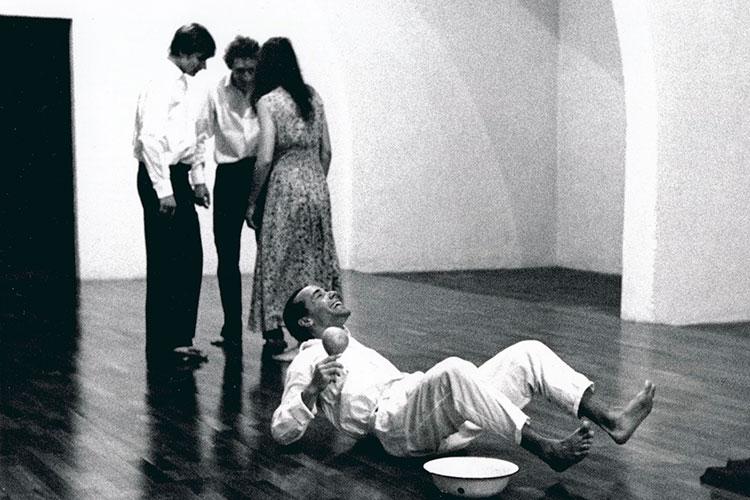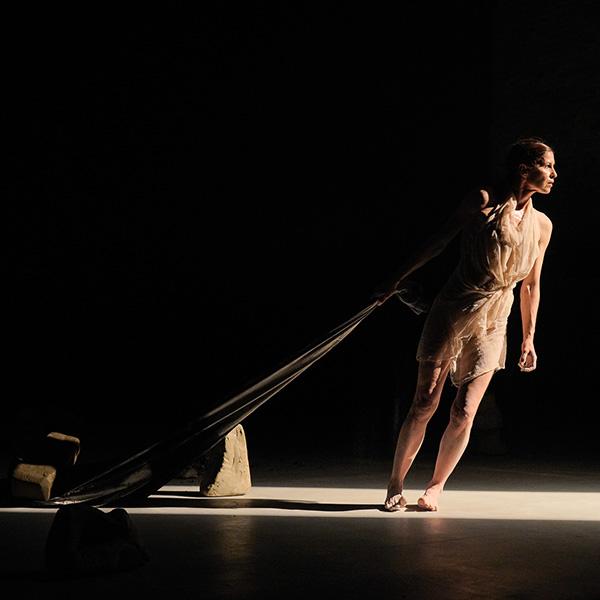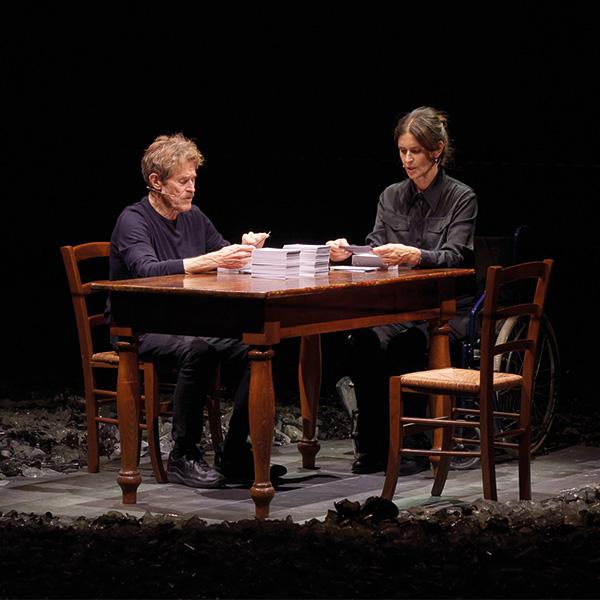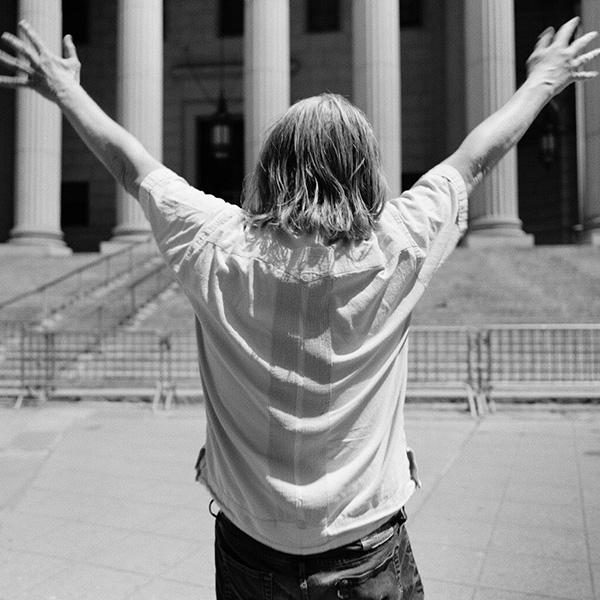
Spazio Cinema at the 53rd International Theatre Festival
Film series at Sala d’Armi-E in the Arsenale scheduled over three days on 6, 7, and 8 June.
Spazio Cinema
The 53rd International Theatre Festival directed by Willem Dafoe, to be held in Venice from May 31st to June 15th, in addition to the programme of plays, encounters and performances will offer the public a film corner, Spazio Cinema, with a selection of films to be screened in Sala d’Armi E at the Arsenale, to be repeated over three days on June 6th, 7th and 8th. “In order to encourage and foster dialogue between theatre and cinema – writes Willem Dafoe – I have asked practitioners at this year’s Festival to contribute to the programme by suggesting a film or documentary that depicts a creative process, reveal its unseen details, or documents the development of production – all with the aim of gaining a better understanding of what theatre is today”.
Spazio Cinema will feature documentaries and filmed versions of some of the works that revolutionised the history of theatre in the second half of the twentieth century. These documentaries and filmed versions have taken on a life of their own, in the intimate relationship between theatre and cinema characteristic of those vibrant and experimental years.
Photo: Przemyslaw Wasilkowski, Mario Biagini, Nhandan Chirco and Thomas Richards in Action, at the Workcenter of Jerzy Grotowski and Thomas Richards, 1995. Photo by Alain Volut. 1995 © Thomas Richards. All rights reserved.
The Performance Group /
The Wooster Group
It will be a surprise to discover that the young Brian De Palma, invited by the actor of his first cult films William Finley, filmed the manifesto-play of the “environmental theatre” theorised by Richard Schechner and his The Performance Group, Dionysus in ’69, inspired by Euripides’ The Bacchae and rife with contemporary references.
The setting is Wooster Street between 1968 and 1969, in a garage converted into a theatre space, an arena disseminated with lofts, towers, platforms shared by the cast and audience, following five months of training and rehearsals of Euripides’ play and exercises in Grotowski’s poor theatre. The result was a groundbreaking production, which engaged the audience in a multisensory experience and would return over and over, making a legend of Dyonisus in ’69. Brian De Palma, the director producer and cinematographer assisted by Robert Fiore and Bruce Rubin, filmed the last two performances, developing his own stylistic solution to “frame it” using the split screen technique, thereby enhancing the power of Schechner’s work at the same time. “A film of extraordinary grace and power”, wrote the New York Times.
With William Finley in the role of Dyonisus, William Shepard as Pentheus, Joan MacIntosh and Ciel Smith as Agave, Richard Dia as Cadmus, Patrick McDermott as Tiresia, and the chorus represented by Jason Bosseau, Remi Barclay, Sam Blazer while all the other characters are portrayed by Margaret Ryan.
That same garage-theatre was also where, under the guidance of the director Elizabeth LeCompte, The Wooster Group took up the legacy of the disbanded The Performance Group. This time it was Ken Kobland, an experimental director of considerable depth who made the videos for the group’s multimedia productions, who authored Flaubert Dreams of Travel. The short film was produced concurrently with the play titled Frank Dell’s The Temptation of St. Anthony, a reinvention of Flaubert’s epic “closet drama” about the visions and ecstasies of the fourth-century hermit Saint Anthony. Kobland’s work, Flaubert Dreams of Travel, focuses on the images of death and transcendence suggested by Flaubert’s writings, conjuring states of hallucination in a stream of sounds and images that makes the walls vibrate and the space dissolve. Artforum considered it to be “one of the most powerful and moving experimental films of the last two decades of the twentieth century”.
With Willem Dafoe, Anna Köhler, Nancy Reilly, Peyton Smith, Irma St. Paule, Kate Valk, Ron Vawter, Jeff Webster.
Rhyme’em to Death is the second short film by the Wooster Group, directed by Leslie Thornton, one of the greatest American experimental filmmakers, assisted by Elizabeth LeCompte. The film reconstructs the trial of the goat in The Hunchback of Notre Dame by Victor Hugo, a postscript in the novel, that here becomes central and is viewed from the perspective of the sacrificed animal, with real transcriptions from fifteenth-century trials, when animals were persecuted as witches. The short 16mm film, in Thornton’s style, uses video effects that alter the black-and-white images of the film, as if remnants of a film had been discovered and assembled, in an imitation of found footage that attempts to faithfully reconstruct a lost art – the aural world of the goat, the distorted rantings of the court room and the blurred sound effects combined with a musical score that drive the narrative to its tragic conclusion.
With the actors of The Wooster Group.
Jerzy Grotowski /
Eugenio Barba
Action centres on the “heretical” theatre practice of Jerzy Grotowski, his idea of a theatre workshop that was founded on the example of the physicists gathered around Niels Bohr, a meeting ground for artists from different countries, who like scientists experiment with the new territories of their profession, and lay at the root of the revolution in the relationship between space-actor-spectator.
Action was a performative opus that was all the more valuable for having been created and directed by Thomas Richards during the final stage of his apprenticeship with the Polish master. Enacted as a daily practice at the Workcenter from 1994 to 2007, Action consisted of precise lines of action woven with and around ancient vibratory songs from Afro-Caribbean and African traditions. In Action, fragments of text, most often in the form of incantation, appeared in English. These texts, that originate from an ancient Judeo-Christian tradition, had been translated for Action word for word from Coptic. Though created within the field of “Art as vehicle” – which focuses on the impact that the work has on those who do it – over the years Action was seen by thousands of people, always in small groups. In 2003, Action was filmed inside the Byzantine church of Aya Irini in Istanbul as part of the Workcenter of Jerzy Grotowski and Thomas Richards’ project Tracing Roads Across (2003-2006),supported by the European Union’s “Culture 2000 Programme”.
Along with Grotowski, the “student” Eugenio Barba, who had contributed to spreading the master’s word around the world, and who based his own theatre, Terzo Teatro, on Grotowski’s legacy: anthropological and intercultural, it was addressed to all those who work in marginal conditions, far from both official and avant-garde theatre.
In the Beginning Was the Idea was filmed by Torgeir Wethal, one of the founders with Barba of the Odin Teatret. He was responsible for all the group’s film productions. In the Beginning Was the Idea is based on one of the most fascinating of Odin’s productions, Oxyrinchus Evangeliet, the Oxyrhynchus Gospels, which at the 1985 Biennale Teatro – record the chronicles – was mobbed by spectators every night for seven nights. “A summa of his work – in the words of the then-director Franco Quadri – a history of humanity, a metaphor for this end-of-the-century, a ceremony of liturgical exorcism”. With its catwalk stage, a place of apparitions, a “river” as Barba liked to call it, along the banks of which stand the spectators, the stories of Antigone and Polynices stories intertwine with that of Zusha Mal’ak, a Hassidic tailor who awaits the Messiah. “And he runs into a society that has already found its Messiah. The performance is in Coptic and in ancient Greek, two dead languages that no one understands anymore. But why isn’t the Messiah coming? Does he perhaps believe that future generations will be better? They will be worse”.
With Roberta Carreri, Tage Larsen, Else Marie Laukvik, Francis Pardeilhan, Julia Varley, Torgeir Wethal.
75 Biennale Ronconi Venezia
In this journey offered by Spazio Cinema running parallel to the festival, an essential testament is the documentary film 75 Biennale Ronconi Venezia. It tells the story of the Biennale Teatro directed by Luca Ronconi in 1975, the famous festival-laboratory that brought together in Venice an entire generation of artists who rose to prominence on the international scene during those years, the same young masters who would leave their mark in the decades that followed: Peter Brook, the Living Theatre, Jerzy Grotowski, Ariane Mnouchkine, Meredith Monk, Andrei Şerban, Giuliano Scabia, Dacia Maraini, and Robert Wilson. The festival attracted hundreds of young people, some of whom would be destined for lengthy careers in the theatre, such as Roberto Bacci, Giorgio Barberio Corsetti, Sandro Lombardi, Federico Tiezzi, Alessandra Vanzi.
Written by Roberta Carlotto and Oliviero Ponte di Pino, directed by Jacopo Quadri, with photography by Greta De Lazzaris, editing by Nicolò Tettamanti, music by Valerio Vigliar.
Thomas Ostermeier /
Romeo Castellucci
The Festival traces the legacy of the new theatre in the twentieth century with some of the most acclaimed names in post-modern and post-drama creativity. And thus, alongside Grotowski, Barba, Schechner and the Wooster Group, following the recommendations of the artists invited to the Festival, it features filmed versions and documentaries of important works by Thomas Ostermeier and Romeo Castellucci.
»Ein Volksfeind« in der Welt is the film adaptation of Ibsen’s An Enemy of the People, which since 2012 has become one of Ostermeier’s most famous productions, presented in countless cities, including Melbourne, Lyon, Montréal, Québec, Athens, Venice, Sao Paulo, Buenos Aires, New York, Paris, Istanbul, Oslo, London, Moscow, Delhi, Kolkata and Chennai, Venice, Naples, Tbilisi, Minsk, Bogotà, Torùn and Seoul.
The play addresses pressing issues in this version of the original text, profoundly reworked by the director: the suffocating economic pressure on a community called upon to make critical decisions about its survival in which the public is involved; the theme of political corruption and the economic crisis; a condemnation of the evils of capitalism, quoting entire excerpts from L’insurrection qui vient, an anarchist pamphlet that circulated online; and with an altered finale, steeped in the cynicism typical of our times and cloaked in an ambiguous silence.
Bros by Romeo Castellucci is presented in the version filmed by Stéphane Pinot. The work by one of our greatest artists focuses on an invisible kafkaesque dictatorship, which makes simple actions unfamiliar, giving rise to unusual situations. The main characters in the play are a group of anonymous men recruited to go on stage without learning their part first. They have underwritten a pact in which they commit to follow orders, to act without understanding, or preparing for them. Dressed in police uniforms, they receive orders through a headset and execute actions with no time to think, to take a stance, to formulate a choice. In this strangled temporality, which reduces everything to an absolute present time, the comic nature of their frenetic and unrehearsed gestures mixes with the violence of their experience of alienation. A play that is as unsettling as it is brilliant, Bros is a deep exploration of individual and collective responsibility and our complex relationship with the law.
Schedule
6/7/8 June – 11:30 am > 8:00 pm
Arsenale - Sala d’Armi E
11:30 am - Dionysus in ‘69 by Richard Schechner/Brian De Palma, Robert Fiore, Bruce Rubin, 1970, USA (85’)
12:55 pm - Flaubert Dreams of Travel but the Illness of his Mother Prevents it by Elizabeth LeCompte (The Wooster Group)/Ken Kobland, 1986, USA (20’)
1:15 pm - Rhyme ’Em to Death by Elizabeth LeCompte (The Wooster Group) / Leslie Thornton, 1993, USA (10’)
1:25 pm - ACTION in Aya Irini by Jacques Vetter/Thomas Richards, 2004, FR (70’)
2:35 pm - In the Beginning Was the Idea by Eugenio Barba/Torgeir Wethal, 1991, DK (70’)
3:45 pm – ‘75 – Biennale Ronconi Venezia by Jacopo Quadri, 2022, IT (84’)
5:10 pm - »Ein Volksfeind« in der Welt by Thomas Ostermeier/Andreas Nickl, Matthias Schellenberg, Schaubühne Berlin, 2017, DE (106’)
6:55 pm - Bros by Romeo Castellucci/Stéphane Pinot, 2022, FR-IT (65’)


